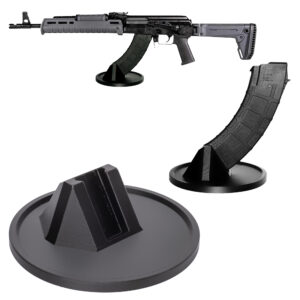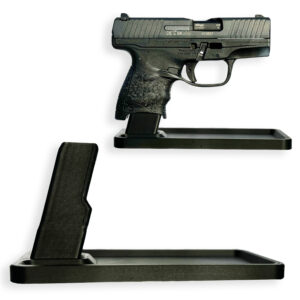Categories:
The AR-15, a popular and versatile rifle originally designed for military use, has become one of the most widely adopted guns among civilian gun enthusiasts. Among the various components that contribute to the AR-15’s reliability and functionality, the forward assist stands out as a crucial feature. The forward assist is a small but pivotal part of the rifle’s design, intended to ensure that the bolt is fully closed and locked into the chamber, especially under conditions where it does not automatically do so during the normal firing cycle.
In operation, the AR-15 is a complex mechanism that relies on the rapid cycling of its bolt carrier group to chamber, fire, and eject cartridges. However, instances can occur where debris, improper lubrication, or other factors impede the smooth cycling of the bolt. When the bolt does not close completely, it can lead to a failure to fire, rendering the rifle inoperative at a critical moment.
It is here that the forward assist becomes indispensable.
The forward assist is located on the right side of the AR-15’s upper receiver. It consists of a plunger and engaging mechanism designed to manually push the bolt carrier forward. When activated, typically by pressing on the thumb-sized plunger, the forward assist forces the bolt carrier into its correct, fully closed position. This action ensures that the bolt is securely locked and ready to fire the next round, effectively restoring the rifle’s functionality.
While some modern AR-15 users may debate the necessity of the forward assist, citing that meticulous maintenance and modern manufacturing standards reduce the likelihood of bolt issues, it remains a valued feature for many. Situations such as extreme environmental conditions or intense usage can still result in the need for manual bolt closure assistance. Whether in a recreational, hunting, or tactical situation, knowing that the forward assist provides an additional layer of reliability is comforting and can make a significant difference in performance and safety.
The forward assist on an AR-15 is a vital component for ensuring the reliability and functional integrity of the gun. Its primary purpose is to manually close the bolt if it does not fully cycle, thereby ensuring the rifle is ready to fire when needed. This mechanism is especially useful in situations where dirt, debris, or any other obstruction may impede the bolt from closing completely on its own, a common occurrence in adverse field conditions or during heavy use.
The forward assist works by providing a manual method of engaging the bolt carrier group and moving it forward into full battery. This engagement is typically achieved through a small button or paddle located on the right side of the rifle, which, when pressed, drives a pawl into the serrations on the side of the bolt carrier. This pawl applies additional forward force, overcoming minor resistance and allowing the bolt to lock into place.
Users often appreciate the forward assist during training or real-world scenarios where rapid response is required, and any malfunction could be critical. For instance, incomplete bolt closure can result in a failure to fire, which in turn may leave the operator vulnerable. In the heat of the moment, quickly pressing the forward assist can resolve such functional hiccups, ensuring that the rifle remains operational.
Despite its importance, the forward assist is sometimes a subject of debate among gun enthusiasts. Critics argue that a well-maintained AR-15 should not need a forward assist if the ammunition is of good quality and the rifle is correctly lubricated. However, supporters counter that having a manual override is invaluable during unexpected situations and can be the difference between a working weapon and a malfunctioning one under stress.
Understanding the function of the forward assist is crucial for anyone who uses an AR-15, from military personnel to civilian shooters. It embodies the principle of redundancy, offering an additional layer of reliability. While it might not be engaged frequently, its presence provides peace of mind and an immediate solution to potential malfunctions, thereby enhancing the overall dependability of the rifle.
In the realm of AR-15 operation, various situations may necessitate the use of the forward assist mechanism. While the semi-automatic functionality of the AR-15 generally ensures a smooth cycling of the bolt, occasional anomalies can impede this process, demanding manual intervention. One prevalent scenario is when the gun is subjected to significant fouling or debris buildup. Carbon deposits, unburned powder, or external dirt can interfere with the bolt’s ability to fully engage the chamber, leaving the gun not fully in battery.
This partial engagement not only affects reliability but also poses safety concerns, making the forward assist an essential tool for ensuring the bolt closes completely, guaranteeing the gun is ready to fire.
Another common situation involves the use of underpowered or unconventional ammunition. Reloads or handloaded rounds, which may not always match the specifications of factory ammunition, can result in the bolt not cycling with sufficient force. Ammunition with inconsistent powder loads might lack the necessary pressure to drive the bolt fully forward. Similarly, subsonic ammunition, often used in suppressed rifles, might cause incomplete cycling due to its lower velocity.
In such cases, the forward assist can be used to manually ensure the bolt’s proper placement.
Environmental conditions also play a significant role. Extreme cold can thicken lubricants, thereby increasing friction and impeding the bolt’s movement. Moisture from rain or humidity can cause parts to stick or corrode slightly, requiring additional manual pressure to seat the bolt. Training exercises or competitions can expose rifles to dust, mud, or other contaminants that interfere with normal operation.
Lastly, operator error in charging the rifle can occasionally result in a bolt that fails to cycle fully. Hesitation or insufficient force when pulling back and releasing the charging handle might lead to incomplete bolt closure. In the heat of rapid engagements or dynamic shooting drills, quick, manual rectification via the forward assist can help maintain operational efficacy.
These varied situations underscore the forward assist’s utility, reinforcing its role as a critical feature for ensuring the AR-15’s reliability across diverse conditions and scenarios.
The forward assist mechanism of the AR-15 is a critical component designed to ensure the reliable closing of the bolt when the rifle experiences cycling issues. This function is especially important in situations where the bolt has not fully returned to its forward position after a round is chambered, which can occur due to various factors such as debris, fouling, or incomplete cycling.
At its core, the forward assist is a simple, yet effective, device. Located on the right side of the rifle’s upper receiver, the forward assist consists of an external plunger that, when pressed, engages the serrated ridges on the bolt carrier. When the shooter notices that the bolt has not fully closed, they can manually press on the forward assist, which then drives the bolt carrier group forward.
This action helps to seat the bolt into the barrel extension, ensuring that the rifle is ready to fire.
The forward assist works through a series of mechanical interactions. When the shooter applies pressure to the forward assist plunger, a small internal pawl engages the tooth-like ridges on the side of the bolt carrier. This engagement allows for a substantial amount of force to be exerted, pushing the bolt carrier forward into its proper locked position. The angled design of the teeth on the bolt carrier ensures that any pressure applied by the forward assist is directed forward, effectively aiding the complete closure of the bolt.
One significant aspect of the forward assist is that it allows the shooter to remedy a partially closed bolt without the need to clear the entire weapon or eject the round. This can be particularly advantageous in combat or self-defense situations where every moment counts and the reliability of the gun is paramount. The use of the forward assist can therefore mitigate the risk of a misfire or failure to fire, which could prove crucial in critical scenarios.
In conclusion, the forward assist mechanism of the AR-15 provides an invaluable function by enabling the manual closure of the bolt, ensuring that the gun remains operational even when encountering minor cycling issues. Its straightforward design and dependable operation make it an essential feature for any AR-15, enhancing the overall reliability and effectiveness of the rifle.
To effectively use the forward assist on an AR-15, it’s essential to understand the mechanism and its purpose. The forward assist is a small, protruding button located on the right side of the rifle. It is designed to help manually close the bolt if it does not fully cycle on its own. This functionality can be crucial in a variety of situations, such as when the gun is dirty, the ammunition is underpowered, or environmental conditions are less than ideal.
First, identify a scenario where the forward assist might be necessary. Typically, you’ll notice that the bolt hasn’t fully closed when the rifle does not fire upon pulling the trigger. Before using the forward assist, ensure that the gun is pointed in a safe direction and that your finger is off the trigger to maintain safety.
Next, visually inspect the bolt carrier group to discern if it is not fully seated. This can be done by slightly pulling back on the charging handle and looking into the ejection port or feeling the bolt’s position. If the bolt is partially closed, it’s time to use the forward assist.
To engage the forward assist, place your thumb or the palm of your hand on the protruding button. Apply firm, steady pressure to push the forward assist in. You may need to press it multiple times, depending on how stuck the bolt is. Each press of the forward assist will nudge the bolt carrier group forward incrementally. You should hear a click when the bolt fully locks into place.
After using the forward assist, conduct a quick visual inspection to confirm that the bolt is fully closed and seated properly. Once you are confident that the bolt is in the correct position, you can proceed to attempt firing the rifle again. Always remain alert for any unusual sounds or mechanical resistance, as these could indicate a more serious issue that might require maintenance or professional inspection.
Using the forward assist is generally a straightforward process, but it does require an understanding of the AR-15’s mechanics and a commitment to gun safety. By familiarizing yourself with this tool, you can enhance the reliability of your rifle under various circumstances.
In tactical scenarios, the AR-15 forward assist can be an indispensable feature that enhances reliability and operational effectiveness. One of the primary benefits of the forward assist is its ability to ensure that the bolt is fully closed and securely locked into the chamber, even when faced with adverse conditions. For soldiers and law enforcement officers, this reliability is critical, as a malfunctioning weapon could result in mission failure or even loss of lives.
In high-stress environments where dirt, debris, or insufficient lubrication can prevent the bolt from cycling properly, the forward assist offers a quick and reliable solution. By providing a manual way to close the bolt, operators can remedy issues without needing to disassemble the gun or break their focus on the immediate threat.
Additionally, the forward assist allows for quieter operation in stealth situations. Manually closing the bolt ensures that the weapon functions with minimal noise, which can be vital for maintaining the element of surprise. In contrast, the noise from re-cycling the charging handle could alert adversaries to one’s position. This tactical advantage is significant in scenarios where silence is paramount for successful engagement or infiltration.
Furthermore, the forward assist serves as an important tool during immediate action drills. When performing functions like chamber checks or clearing malfunctions, the forward assist simplifies the task, saving precious seconds in life-or-death situations. A quick tap on the forward assist can resolve minor issues on the spot, allowing the operator to stay engaged and maintain situational awareness.
In scenarios with rapidly changing dynamics, the ability to manually guarantee the bolt’s closure supports overall gun readiness, enhancing confidence and proficiency. The forward assist’s inherent simplicity allows even less experienced users to effectively troubleshoot and rectify cycling issues, ensuring that the weapon remains combat-ready. This benefit cannot be overstated in tactical contexts where every second and every action can influence the outcome of an engagement.
Given its utility and the increased reliability it offers, the forward assist stands as a crucial feature in the AR-15 platform for tactical operatives.
The maintenance and troubleshooting of the AR15 forward assist are crucial aspects of ensuring the reliability and functionality of your gun. The forward assist is designed to manually help close the bolt if it does not fully cycle, which can be vital in certain situations. Regular maintenance and an understanding of common troubleshooting techniques can help prevent and resolve issues associated with this component.
Regular cleaning is essential for maintaining the forward assist. Residue from gunpowder and environmental debris can accumulate in and around the forward assist mechanism, potentially causing it to become sticky or unresponsive. To clean the forward assist, first ensure that the gun is unloaded and the bolt carrier group is removed. Using a suitable gun cleaning solvent, brush, and cloth, carefully clean the forward assist button and the internal parts that interact with it.
Pay close attention to any signs of wear or damage, as these can indicate the need for replacement parts.
Lubrication is another vital maintenance task. After cleaning, applying a light coat of high-quality gun oil to the forward assist and its surrounding components can help ensure smooth operation. However, over-lubrication can attract dirt and debris, so it is important to use oil sparingly. Regularly check the forward assist for proper function by manually activating it and observing its movement and interaction with the bolt carrier group.
If the forward assist is not functioning correctly, specific troubleshooting steps can help diagnose and fix the issue. Start by inspecting the button and pawl for physical damage or excessive wear. Check the spring tension; a weak or broken spring can lead to a non-functional forward assist. Additionally, examine the receiver for any deformations or debris that might obstruct the forward assist mechanism.
If the problem persists, consider consulting a gunsmith or the gun’s manufacturer for further assistance.
In conclusion, consistent maintenance and prompt troubleshooting of the AR15 forward assist are key to ensuring the reliability of your gun. By keeping it clean, properly lubricated, and addressing any issues immediately, you can ensure that the forward assist remains operational when you need it most.








Colt
Colt M4 Carbine
Colt LE6920
Colt AR-15 A4
Daniel Defense
DDM4 V7
DDM4 V9
DDM4 V11
DDM4 ISR (Integrally Suppressed Rifle)
Smith & Wesson (S&W)
M&P15 Sport II
M&P15 Tactical
M&P15T
Bravo Company Manufacturing (BCM)
BCM Recce-16
BCM Recce-14
BCM MCMR Series
Aero Precision
M4E1 Series
AC-15
AR15 Pistol (Various Configurations)
Ruger
Ruger AR-556
Ruger SR-556
Ruger AR-556 MPR (Multi-Purpose Rifle)
Springfield Armory
Saint Victor
Saint Edge
Saint AR-15
PSA (Palmetto State Armory)
PSA PA-15
PSA AR-V
PSA Jakl (AR Pistol)
FN America
FN 15 Tactical Carbine
FN 15 Patrol
FN 15 DMR
Wilson Combat
Recon Tactical
Super Sniper
Protector Carbine
SIG Sauer
SIG M400 Tread
SIG M400 Elite
SIG M400 SDI
LWRC International
IC DI (Direct Impingement)
IC SPR
IC A5
Bushmaster Guns
XM-15 QRC
Bushmaster MOE
XM-15 Patrolman
Rock River Arms
LAR-15 Entry Tactical
LAR-15 Predator
LAR-15 Elite Comp
Stag Arms
Stag 15 Tactical
Stag 15L (Left-Handed Models)
Stag 15 Valkyrie
Noveske Rifleworks
Noveske Gen 4 N4
Noveske Space Invader (AR Pistol)
Noveske Recon
Anderson Manufacturing
AM-15 Optic Ready
AM-15 M4 Carbine
AM-15 Precision Rifle
Adams Arms
AA-15 Piston Rifle
P2 AARS (Adams Arms Rifle Series)
Black Rain Ordnance
SPEC15 Series
BRO Predator
Fallout 15
Diamondback Guns
DB15 Series
DB15CCMLB
DB15EB
Del-Ton Inc.
DTI-15
Del-Ton Echo 316H
Sierra 316M
Windham Weaponry
Windham SRC
Windham VEX-SS
Windham RMCS-4 (Caliber Conversion System)
Christensen Arms
CA-15 G2
CA-15 Recon
CA-15 Titanium Edition
Patriot Ordnance Factory (POF-USA)
Renegade Plus
P415 Edge
Revolution DI
LaRue Tactical
PredatAR
OBR (Optimized Battle Rifle)
LaRue Stealth 2.0
Battle Arms Development
Workhorse Patrol Carbine
BAD556-LW (Lightweight)
Authority Elite Rifle
Faxon Guns
Ascent AR-15
FX-19 (AR Pistol)
Streamline Ultralight Series
KE Arms
KE-15 SLT (Super Lightweight Tactical)
KE-15 Scout Carbine
Primary Weapons Systems (PWS)
MK1 MOD 2-M
MK116 PRO
MK107 (Piston AR Pistol)
ZEV Technologies
ZEV Core Elite Rifle
ZEV AR15 Billet Rifles
Franklin Armory
BFSIII AR-C1
Militia Model
F17-L (Chambered in .17 WSM)
Seekins Precision
SP15 DMR
NX15 Skeletonized Rifle
Havak Bravo
Aero Precision (Additional Models)
EPC-9 (Pistol Caliber ARs)
VG6 AR Rifles
Barrett Guns
REC7 DI
REC7 Gen II
CMMG
MK4 RCE
Resolute 300
Banshee (AR Pistol)
DPMS Panther Arms
Panther Oracle
Panther LR-308
H&K (Heckler & Koch)
HK MR556A1
HK416 (Military Variant)
Rock Island Armory (Armscor)
VR-80 Tactical AR (Shotgun AR Platform)
Troy Industries
Troy SPC-A3
Troy PAR (Pump Action AR)
Wilson Tactical
Tactical Recon AR
Protector Series
F1 Guns
FDR-15 Skeletonized Rifle
BDRx-15 Series
Juggernaut Tactical
JT-15
JT-10 Precision Rifle
AeroSurplus
Surplus AR-15 Rifles (Budget Models)
Thunder Tactical
AR-15 Basic Carbine
Tactical Builder Sets
Radical Guns
RF-15
Forged AR-Series
Dark Storm Industries
DS-15 Featureless Rifles
DS-10 Typhoon
DRD Tactical
Paratus
Aptus AR Rifles
Bear Creek Arsenal
BCA-15
AR Complete Upper Builds
Aero Survival Rifles (ASI)
ASR Tactical Series
Tactical Edge
WARFIGHTER Series
AR-15 Lightweight Rifles
Lone Star Armory
TX15 DMR
TX15 Carbine
HERA Arms
HERA H7
HERA AR-15 Lower Builds
IWI (Israeli Weapon Industries)
Zion-15
DRD Tactical
Tactical Modular Rifles
Quick-Takedown Rifles
V Seven Weapons
1776 Rifle
Hyperlite Rifle
Core Rifle Systems
Core15 Tac III
Core15 Patrol Rifle
Armalite (Original AR-15 Creator)
M15 Tactical
M15 A4 Carbine
DEF15 (Defensive Sporting Rifle Series)
PSA (Palmetto State Armory Additional Models)
PSAK-47 Hybrid (AR-AK Style Hybrid)
PSA Dagger (Pistol Caliber Configurations)
Odin Works
OTR-15
Odin Recon Rifle
Maxim Defense
MDX-508 PDX (Compact AR Pistol)
MDX-510 Rifle